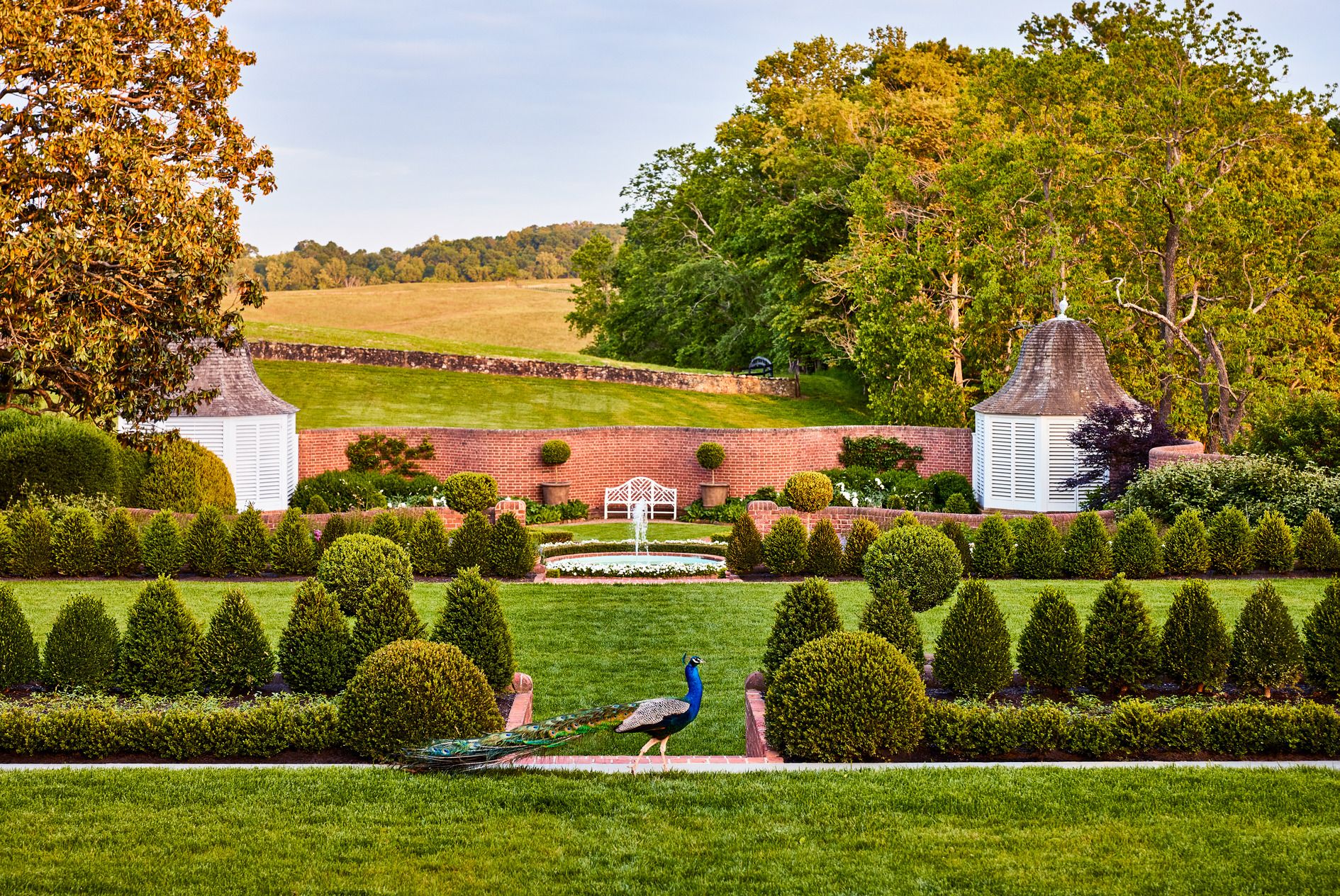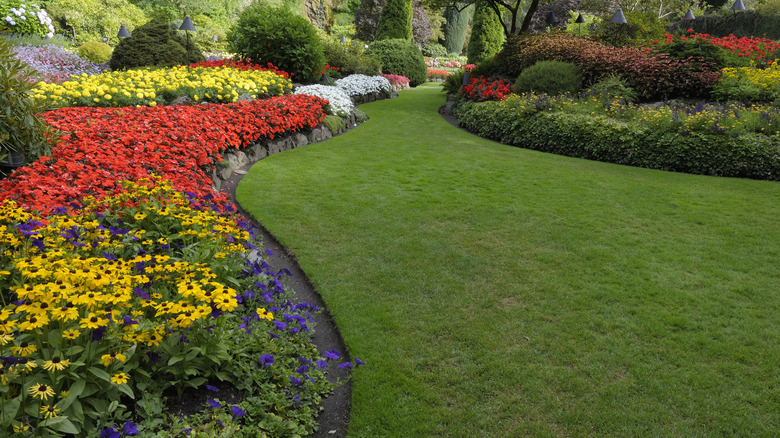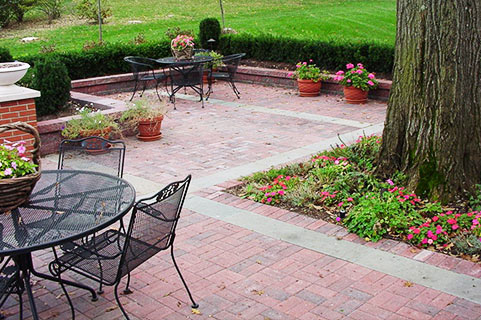How to Find the Best Outdoor Lighting Installer for Your Home Transformation
Exploring Different Kinds of Landscape Design to Improve Your Outdoor Setting
Landscape design plays an essential role in defining outside rooms. Different designs, from standard gardens to modern minimal designs, supply distinct benefits for enhancing aesthetics and function. Including aspects like xeriscaping and native plants can add to eco-friendly balance. Comprehending the interaction of hardscape and softscape is crucial for developing inviting settings. The options offered can be frustrating, triggering one to show on which style best lines up with their vision for an outside shelter.
Typical Garden Landscaping

While lots of contemporary gardens embrace minimalism and native plantings, conventional yard landscape design continues to be a cherished strategy that stresses symmetry, structure, and ornamental features. This style frequently integrates formal geometric layouts, where flowerbeds, paths, and bushes are set up with accuracy. Central prime focus, such as fountains or sculptures, attract the eye and give a sense of harmony.Traditional landscape design often includes a selection of plant kinds, showcasing seasonal blooms and evergreen elements. Classic shrubs, perennials, and annuals create dynamic shades and textures throughout the year. Additionally, pergolas, arches, and trellises add vertical rate of interest and function as support for climbing up plants, boosting the total aesthetic.The use natural products, such as stone and timber, more enhances the standard landscape, adding to an ageless high quality. Eventually, this design invites relaxation and pleasure, making it a cherished selection for those seeking a picturesque outdoor environment.
Modern Minimalist Landscape Design
Modern minimal landscape design emphasizes simplicity and performance, characterized by clean lines and open areas. Key qualities consist of a minimal plant palette and thoughtful hardscape design that focuses on functionality and visual allure. Effective plant option strategies even more enhance the minimalist method, creating serene outdoor settings that encourage relaxation and consideration.
Key Characteristics of Minimalism
A growing fad in landscaping is the welcome of minimalism, identified by simplicity and capability. Minimal landscaping focuses on tidy lines, open rooms, and a restricted shade palette, promoting a sense of tranquility. Components are meticulously curated to stay clear of clutter, enabling each component to stand apart. Using all-natural materials, such as rock and timber, improves the natural feel while maintaining a visual balance. Additionally, minimal designs frequently incorporate geometric forms, which can produce aesthetic interest without frustrating the detects. Water attributes may be included, functioning as centerpieces that boost peacefulness. Overall, minimalism in landscape design stresses the beauty of restraint, allowing nature's fundamental top qualities to radiate through in an unified outdoor environment.
Plant Option Approaches
Efficient plant selection is necessary for achieving the wanted visual in modern-day minimal landscaping. The emphasis should be on simpleness, using a minimal scheme of plants that enhance each various other and the surrounding environment. Indigenous plants are typically suitable, as they require much less maintenance and water, advertising sustainability. Picking types with varying elevations and appearances can add aesthetic rate of interest without frustrating the room. Grouping plants in collections instead of scattering them enhances communication and strengthens the minimalist style. Evergreen selections can offer year-round framework, while seasonal blossoms introduce refined shade changes. Ultimately, the objective is to create a serene outdoor room that embodies tranquility and harmony with thoughtful plant choices.
Hardscape Style Concepts
Vital elements in hardscape layout significantly contribute to the overall aesthetics and performance of minimalist landscape design. This style approach highlights tidy lines and understated materials, developing a clean aesthetic experience. Secret parts consist of paths, patio areas, and maintaining walls, which not just define areas however additionally improve accessibility and usability. The use of materials such as concrete, rock, and timber prevails, reflecting an all-natural yet contemporary aesthetic. Integrating geometric shapes and in proportion designs better strengthens the minimalist philosophy, permitting a harmonious blend with surrounding plant. Furthermore, correct drain and disintegration control are vital factors to consider, ensuring durability and sustainability. Ultimately, reliable hardscape layout offers as a foundation that complements softscape components while keeping equilibrium and simplicity in outside atmospheres.
Cottage-Style Landscape design
Cottage-style landscape design uses a wonderful technique to developing welcoming exterior spaces. By incorporating charming plant combinations, this style cultivates a feeling of warmth and fancifulness. The focus on cozy, well-defined areas urges leisure and satisfaction of nature.
Enchanting Plant Mixes
Although lots of property owners seek to produce an attractive outdoor room, attaining the appeal of cottage-style landscape design usually pivots on thoughtful plant combinations. Lively blossoms, rich foliage, and aromatic natural herbs can be skillfully combined to evoke a sense of fancifulness and nostalgia. Incorporating lavender, daisies, and foxgloves produces a vibrant tapestry that attracts pollinators while providing a fascinating scent. Integrating decorative grasses like miscanthus can include structure and activity, enhancing the softer blossoms. In addition, mixing yearly and perennial plants guarantees continuous shade throughout the seasons. Making use of climbers, such as clematis or honeysuckle, can enhance vertical passion. In general, these combinations not only improve the landscape but additionally promote a welcoming and captivating atmosphere.

Relaxing Outdoor Areas
Producing cozy exterior spaces needs a cautious blend of comfort and beauty, complementing the dynamic plant mixes found in cottage-style landscape design - Outdoor Lighting Installer. These locations often include inviting seating arrangements, such as weathered wooden benches or supported chairs bordered by lush plant. Soft illumination, like fairy why not look here lights or lanterns, includes warmth, transforming the area right into a tranquil retreat. Integrating aspects such as trellises adorned with climbing up roses or aromatic herbs enhances sensory experiences. Additionally, paths made of rustic rocks invite expedition and link with nature. Decorative touches like birdbaths or wayward yard art add to a sense of fancifulness. Ultimately, the objective is to create a charming atmosphere that motivates relaxation and pleasure of the appeal bordering these relaxing outside places
Xeriscaping for Water Conservation
Just how can neighborhoods balance visual landscaping with journalism demand for water conservation? Xeriscaping arises as a viable solution, advertising lasting methods that reduce water usage while improving exterior elegance. This landscape design approach concentrates on making use of drought-resistant plants belonging to the area, which call for significantly less water than traditional yards. By incorporating compost and effective irrigation systems, xeriscaping reduces evaporation and overflow, further saving valuable water resources.Communities can create visually attractive landscapes via careful planning, selecting a varied range of structures and shades that grow in dry conditions. Additionally, xeriscaping motivates the use of decorative rocks and decorative crushed rock, offering functional and appealing options to yard yards. As communities accept this eco-friendly method, they not just reduce their water intake however likewise promote biodiversity and durability in their local environments. Inevitably, xeriscaping acts as a demo of the harmony between aesthetic allure and environmental responsibility.
Hardscape Design Aspects
Hardscape layout elements play an important function in enhancing outside spaces by giving framework and capability. These non-plant functions, such as patios, pathways, decks, and wall surfaces, create visual rate of interest while offering useful purposes. Making use of products like concrete, block, and stone, hardscaping adds to the general aesthetic appeal and sturdiness of a landscape.Incorporating hardscape elements can define locations within a backyard, assisting movement and encouraging social interaction. A well-placed pathway can attach various sections of the yard, while keeping wall surfaces can handle elevation adjustments and protect against erosion.Furthermore, hardscape design can boost accessibility and safety, giving secure surface areas for relaxing or strolling. Efficient combination of hardscape elements complements soft landscaping, making certain a balanced outside environment. Inevitably, thoughtful hardscape layout improves not only the elegance of exterior rooms however likewise their use, making them a lot more welcoming and functional for visitors and home owners alike.
Exterior Living Spaces
While outdoor home use a smooth mix of convenience and nature, they work as vital expansions of a home, boosting way of living and leisure. These areas can consist of outdoor patios, decks, or outside kitchen areas, created to foster relaxation and entertainment. Grill Islands. By incorporating practical furnishings and elegant design, homeowners develop welcoming environments for celebrations or peaceful evenings.The assimilation of shade structures, such as awnings or pergolas, safeguards versus the elements while keeping an open feel. Fire pits and outdoor heaters prolong functionality into cooler months, giving warmth and atmosphere. Additionally, integrating illumination features boosts the room's functionality after sundown, creating a magical night atmosphere.Landscaping components, such as paths and borders, further define these locations, guiding movement and adding visual appeal. Inevitably, outside living areas change backyards into go to this website versatile resorts, advertising a lifestyle that welcomes both nature and convenience
Indigenous Plant Landscaping
Native plant landscaping stresses using native vegetation to produce harmonious and lasting exterior environments. This strategy not just enhances biodiversity but also preserves water and decreases the need for chemical fertilizers and chemicals. By selecting plants that are belonging to a details region, home owners can ensure that their landscapes are well-adapted to regional soil and climate conditions, resulting in lower maintenance requirements.Additionally, native plants offer important environments for neighborhood wildlife, consisting of butterflies, birds, and bees, promoting ecological wellness. Landscape designs that include these plants frequently feature naturalistic layouts that simulate local ecosystems, fostering a local color and link to the environment.Furthermore, indigenous plant landscaping can add to soil stability and disintegration control, making it an environmentally liable option. On the whole, this technique not just beautifies exterior areas however also sustains the neighborhood community, creating a lasting balance in between human task and nature.

Often Asked Questions
Exactly How Can I Choose the Right Landscape Design Style for My Home?
Selecting the ideal landscape design style for a home entails reviewing the building's style, climate, and personal preferences. Retaining Wall Installation. Researching various designs and consulting specialists can supply guidance to produce a harmonious exterior space customized to private demands
What Is the Ordinary Cost of Expert Landscape Design Providers?
The average cost of specialist landscape design solutions normally ranges from $1,000 to $5,000, depending on task place, size, and complexity. Homeowners must consider acquiring numerous quotes to guarantee they receive fair prices and useful source quality service.
Just how Often Should I Preserve My Designed Lawn?
The regularity of keeping a landscaped yard typically relies on the plants and attributes present. Typically, regular maintenance every few weeks is recommended, with seasonal jobs enhancing in regularity during optimal expanding seasons for excellent health and wellness and looks.
Exist Landscaping Options for Little Urban Spaces?

Numerous landscaping choices exist for small city spaces, including vertical yards, container plants, and rooftop gardens. Integrating these elements can make the most of restricted areas while supplying plant, improving appearances, and enhancing air high quality in urban settings.
What Plants Are Best for Attracting Neighborhood Wildlife?
The very best plants for drawing in neighborhood wildlife consist of indigenous blooming species, berry-producing bushes, and diverse yards. These plants provide important food and habitat, fostering a prospering ecosystem that supports various birds, bugs, and small animals. Numerous property owners seek to produce a picturesque outside area, achieving the appeal of cottage-style landscape design usually hinges on thoughtful plant mixes. Producing comfortable outside spaces requires a cautious mix of comfort and appeal, complementing the vibrant plant combinations discovered in cottage-style landscape design. Native plant landscaping highlights the use of native vegetation to create harmonious and sustainable outdoor environments. Landscape creates that incorporate these plants usually include naturalistic designs that simulate local environments, fostering a sense of place and connection to the environment.Furthermore, native plant landscape design can contribute to dirt stability and erosion control, making it an eco responsible selection. Various landscaping alternatives exist for small metropolitan spaces, consisting of vertical yards, container plants, and roof yards.